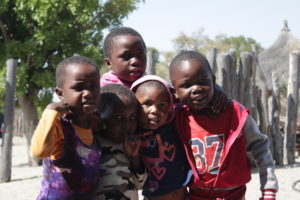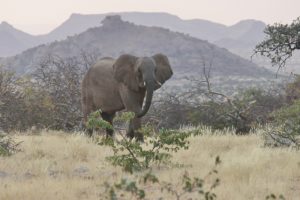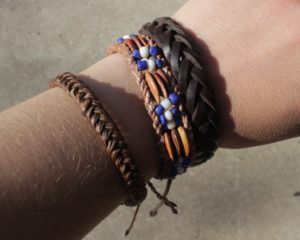Coming to Namibia, I never thought there would be so many similarities between here and home. One very strong similarity I discovered is the sense of community. Communities are the same in the United States of America and Namibia in that people watch out for and help each other. In Namibia, men from rural areas work in town and send money back to support their families because they do not earn enough cash to buy groceries. Likewise, in the United States, some people choose to commute hours to work instead of moving because they are tied to where they grew up and where their extended families are located.

Some of the children from the Ncamagoro village briefly stop playing to pose as we take their picture.
Namibia’s rural areas’ sense of community is family. Unfortunately, this is not always by choice, but by circumstance, that they stay and take care of each other. When you enter a village, you see homesteads with family members of all ages from infants to grandparents. The same is similar in rural areas in the United States. Some towns contain a number of families that include several generations. Similar to the culture in the United States, Namibians love to open their homes and share and teach their culture to others. When we visited the Ncamagoro village, they prepared a meal, sang to us and showed us around their town and homestead.

This is a desert elephant we saw on a game drive while visiting Twyfelfontein. Twyfelfontein is part of the Twyfelfontein Uibasen Conservancy located in the Huab valley in Namibia.
Another aspect of community life is taking advantage of community-based natural resource management. In the United States, one example would be water regulations in times of drought. In Namibia, communities utilize tourism for helping conserve the land and wildlife. According to Brian T. B. Jones, “The process of addressing sustainable development on communal land has been initiated by the Namibian Government which, among other activities, has put its faith in a community-based approach to natural resource management (CBNRM). This approach aims to provide communal area residents with appropriate incentives to use their resources sustainably.” An example that we encountered on our trip is the desert elephants that live around the farms in the Twyfelfontein area. The elephants can be destructive to the land by plowing down fences, harming crops and even sometimes harming people. To counter balance, the community takes advantage of the interest of tourists by taking them on game drives to see these elephants. This in turn saves the elephants while the farmers make money to support themselves and their families.

These are bracelets bought from various tribes we visited.
Also, travel lodges throughout Namibia employ locals. This makes sense from a business standpoint and helps support the surrounding community members. The lodges take the same approach in their gift shops by supplying crafts for purchase made by locals to help promote the area, the people and their culture. The importation of goods may be more expensive and therefore the lodges buy items made locally to support the community. Furthermore, tourists that visit these lodges may buy more items if the merchandise is locally made. Another aspect of this is that some of the lodges and other businesses are actually run by locals and prefer to employ the locals. For example, if someone in the Damara community is hiring, he will most likely hire another Damara instead of someone from another community. The same can be said in the United States: if an Aggie is hiring, they might prefer to hire another Aggie. As we travel through Namibia, we continue to see that the United States and Namibia have a strong sense of community of watching out for and helping each other.